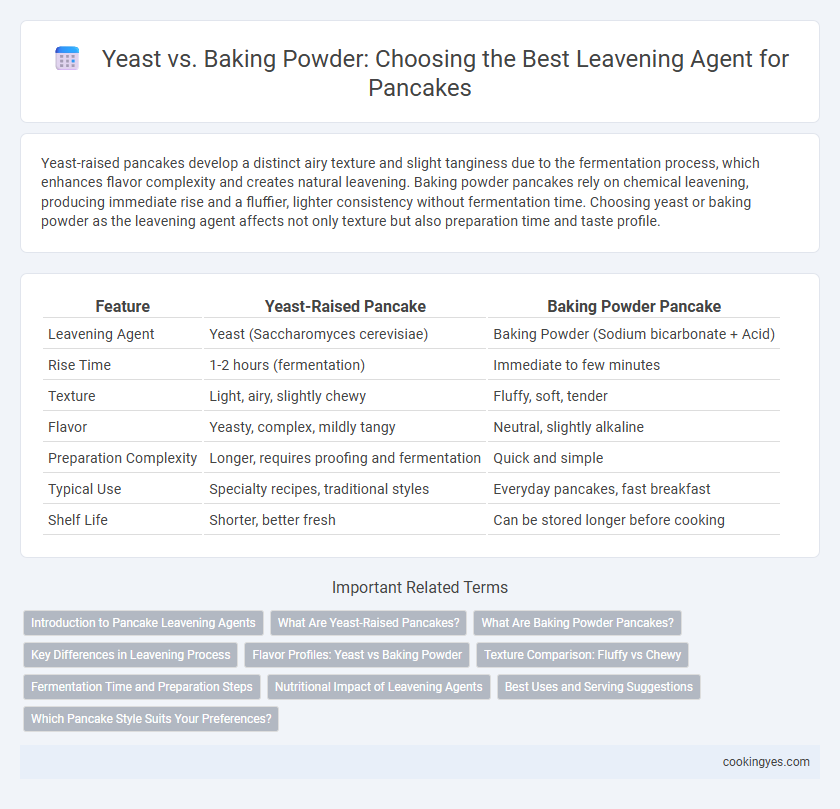Yeast-raised pancakes develop a distinct airy texture and slight tanginess due to the fermentation process, which enhances flavor complexity and creates natural leavening. Baking powder pancakes rely on chemical leavening, producing immediate rise and a fluffier, lighter consistency without fermentation time. Choosing yeast or baking powder as the leavening agent affects not only texture but also preparation time and taste profile.
Table of Comparison
| Feature | Yeast-Raised Pancake | Baking Powder Pancake |
|---|---|---|
| Leavening Agent | Yeast (Saccharomyces cerevisiae) | Baking Powder (Sodium bicarbonate + Acid) |
| Rise Time | 1-2 hours (fermentation) | Immediate to few minutes |
| Texture | Light, airy, slightly chewy | Fluffy, soft, tender |
| Flavor | Yeasty, complex, mildly tangy | Neutral, slightly alkaline |
| Preparation Complexity | Longer, requires proofing and fermentation | Quick and simple |
| Typical Use | Specialty recipes, traditional styles | Everyday pancakes, fast breakfast |
| Shelf Life | Shorter, better fresh | Can be stored longer before cooking |
Introduction to Pancake Leavening Agents
Yeast-raised pancakes rely on fermentation to produce carbon dioxide, creating a distinct airy texture and complex flavor profile. Baking powder pancakes use chemical leavening agents that quickly release gas when exposed to moisture and heat, resulting in a lighter and fluffier consistency. Understanding these leavening differences is essential for achieving desired pancake textures and flavors.
What Are Yeast-Raised Pancakes?
Yeast-raised pancakes use yeast as the leavening agent, which produces carbon dioxide through fermentation, resulting in a light, airy texture with a slightly tangy flavor. Unlike baking powder pancakes that rely on chemical reactions for quick rise, yeast pancakes require longer fermentation time for optimal fluffiness and complex taste development. This natural leavening process enhances the pancake's softness and creates characteristic bubbles throughout the batter.
What Are Baking Powder Pancakes?
Baking powder pancakes use a chemical leavening agent composed mainly of sodium bicarbonate and an acid salt, which creates carbon dioxide gas when mixed with liquid and heat, causing the batter to rise quickly. These pancakes typically have a light, fluffy texture and a slightly tangy flavor due to the acid-base reaction during cooking. In contrast to yeast-raised pancakes, baking powder pancakes are faster to prepare since they do not require fermentation time.
Key Differences in Leavening Process
Yeast-raised pancakes rely on yeast fermentation, which produces carbon dioxide slowly, resulting in a thicker batter and a chewier texture with complex flavors. Baking powder pancakes use chemical leavening agents that react immediately with liquid and heat to release carbon dioxide, producing a lighter, fluffier pancake with a tender crumb. The key difference lies in the time and method of gas production: yeast requires fermentation time for leavening, while baking powder acts rapidly during cooking.
Flavor Profiles: Yeast vs Baking Powder
Yeast-raised pancakes exhibit a complex, slightly tangy flavor due to fermentation that enhances depth and richness, alongside a chewier texture. Baking powder pancakes deliver a more neutral, mildly sweet taste with a light, fluffy texture, emphasizing quick rise without the fermentation notes. The choice between yeast and baking powder impacts flavor complexity and mouthfeel, tailoring the pancake experience to preference.
Texture Comparison: Fluffy vs Chewy
Yeast-raised pancakes develop a chewy texture due to the slow fermentation process, which creates a complex network of gluten and air pockets, resulting in a denser but tender bite. Baking powder pancakes produce a fluffy and soft texture by releasing carbon dioxide rapidly during cooking, which expands the batter and creates light, airy pockets. The choice between yeast and baking powder directly influences whether the pancake texture leans toward chewy richness or fluffy lightness.
Fermentation Time and Preparation Steps
Yeast-raised pancakes require a fermentation time of several hours, allowing natural yeast to produce carbon dioxide and develop a complex flavor profile. In contrast, baking powder pancakes rely on chemical leavening, enabling immediate preparation without waiting for fermentation. The preparation steps for yeast-raised pancakes include mixing the batter and proofing, whereas baking powder pancakes involve simply combining ingredients and cooking right away.
Nutritional Impact of Leavening Agents
Yeast-raised pancakes utilize yeast as a leavening agent, promoting fermentation that can increase B vitamins and improve digestibility, while baking powder pancakes rely on chemical reactions producing carbon dioxide for immediate rise without nutritional enhancement. Yeast fermentation also yields slight increases in protein quality and bioavailability, offering additional health benefits compared to baking powder's inert role in nutrition. Choosing yeast-raised pancakes may support gut health through fermentation byproducts, whereas baking powder pancakes provide quicker preparation but minimal impact on nutritional content.
Best Uses and Serving Suggestions
Yeast-raised pancakes offer a light, airy texture ideal for specialty brunch dishes and pair exceptionally well with savory toppings like smoked salmon or hollandaise sauce. Baking powder pancakes provide a quick and fluffy option perfect for everyday breakfasts, complementing sweet additions such as maple syrup, fresh berries, and whipped cream. For a gourmet twist, yeast-raised pancakes can be served as a base for inventive fillings, while baking powder pancakes remain a versatile choice for straightforward, crowd-pleasing meals.
Which Pancake Style Suits Your Preferences?
Yeast-raised pancakes develop a rich, slightly tangy flavor and airy texture due to natural fermentation, ideal for those who enjoy a complex taste and fluffier bite. Baking powder pancakes offer quick preparation with a light and tender texture, perfect for convenience and a mildly sweet flavor. Choose yeast-raised pancakes for traditional, depth of flavor or baking powder pancakes for speed and consistent rise.
Yeast-raised pancake vs Baking powder pancake for leavening agent Infographic

 cookingyes.com
cookingyes.com